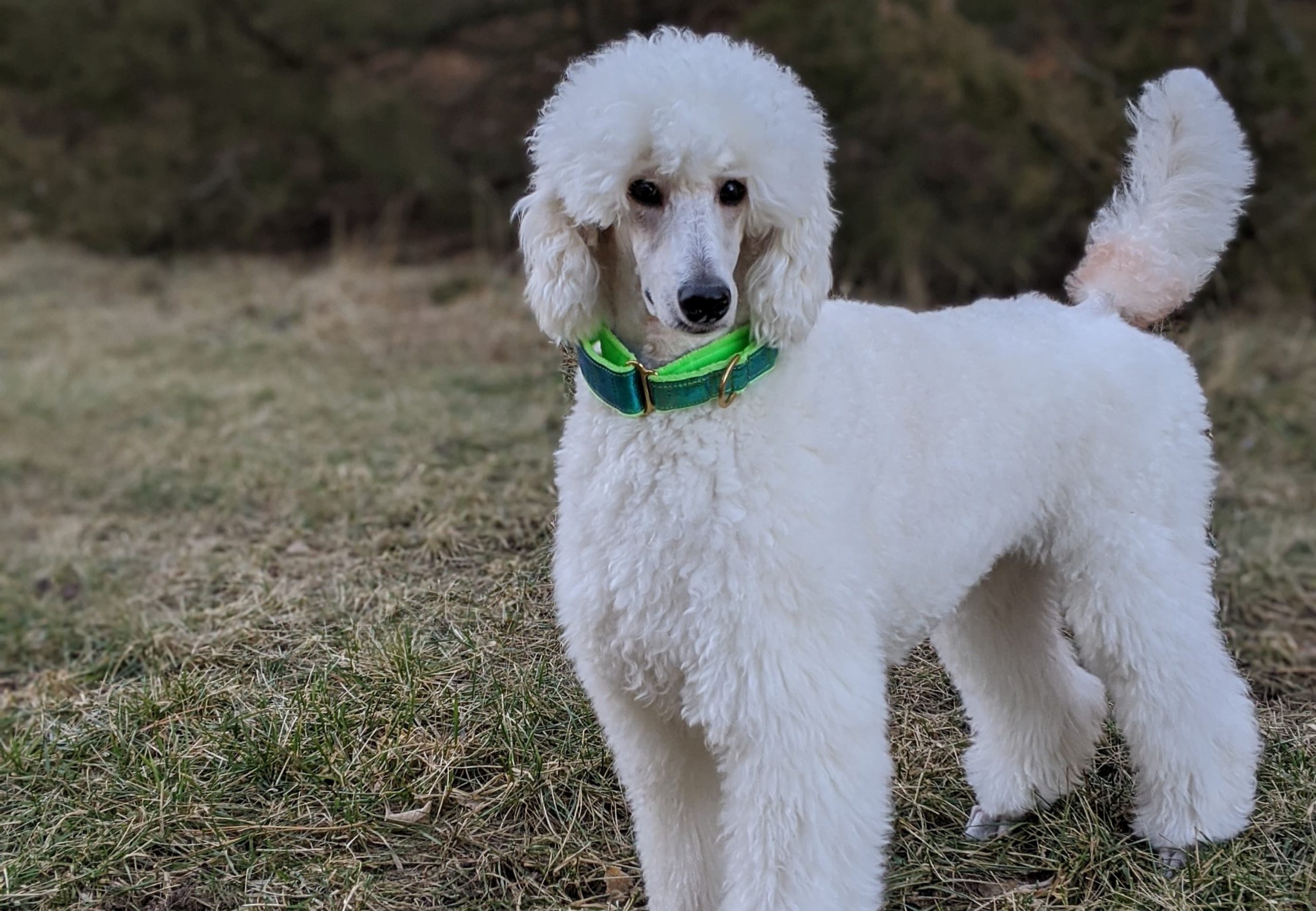
Test breeding – Standard Poodles
The Standard Poodle population has been found to have a very severe genetic bottleneck. But, when we say that, what really do we mean? We mean that a majority of the dogs in the population carry most of the same genes, passed down from the same ancestors, while very few have less common genes that come from different ancestors. Thus there are lots of well represented genetics in the breed and only some of the genetics are not well represented. The cause? In general when this happens with breeds, it is caused by popular sires, World Wars, or a decline in the popularity of a breed. In the case of the Standard Poodle, a part of this was caused by a few kennels that had gorgeous tightly bred dogs in the mid century, and due to their gorgeous dogs, many bred to them. The result was that many dogs in the population are gorgeous and typey (have “the look”). However, this also concentrated the genes that can cause breed specific diseases like sebaceous adenitis and Addison’s disease. If you would like to read the study on the genetic status of the Standard Poodle, click here. If you would like to read about the way our management can affect our genepools similar to the Standard Poodle, click here. The only genepool yet analyzed by UC Davis that shows a more dramatic genetic bottleneck than the Standard Poodle is the Doberman Pinscher.
As always, we emphasize that breeding is about more than numbers. When breeding with BetterBred, you must always still consider everything that you have as before. However, these new tools should play a part in decision making like anything else. After a breeding is done and puppies are on the ground, selection for type, temperament and genetic diversity should all play a part in our decision making. Which criteria each breeder will emphasize will depend on their personal tolerances, what they have in their own program, and their goals for the future.
When we breed a Standard Poodle, on what should we place emphasis? Because of the genetic bottleneck mentioned above, we encourage breeders to attempt to raise their Outlier Index each generation. What is the Outlier Index? The Outlier Index is a proprietary measurement on BetterBred, which was developed to help breeds keep their biodiversity well distributed, when used in conjunction with our other breed management measurements. A dog with a very high Outlier Index will have genetics that are not well represented in the population and therefore should be given more consideration in order to not lose those genetics to genetic drift. (Wonder if a breed can be typey and have high Outlier Index? Compare your breed to other breeds in our database!)
Generally when people first join our program, they want one number, or one yes or no answer on a breeding. Genetic diversity testing and litter simulations should be considered more like our overall breedings. Each generation is a concert of considerations – that front, temperament, headpiece, drive – these are all something we consider as a whole part of the overall picture of the dog and our goal for the next generation. We may have individual preferences, but most realize that what might be the pick for one person would not be the pick of another. This is one of the beautiful aspects of breeding, our differences make up our contribution to the future for our breed.
What exactly is biodiversity, simply put – or the variation we are discussing here?
The best explanation I’ve yet read is from BetterBred Founder Natalie, and as a result we will share it again here!
Most breeders think of DNA as coming in two options- a good gene, or a mutant gene – like it is in many DNA tests. In fact, there are many genes or (in the case of the VGL canine diversity test) markers that come in a great many variations – like a t-shirt that is available in different colors. The more variants there are, the more information we have about population genetics. In more inbred breeds, there are fewer variants for each marker. So an inbred breed might have only a few colors available in t-shirts, whereas a diverse breed will have many colors of t-shirts. Apart from the relatively small number of genes that make up specific, predictable, visible breed traits, the rest of the gene pool is generally healthier when there’s lots of variation.
Unfortunately when breeders select too strictly for too long for very specific traits, there can be an unintended loss of variation in the parts of the DNA that are more beneficial when they have more variation. A good way to assess whether that good variation has been impacted is using markers like those used in the VGL canine diversity test. Because they are considered neutral – or not associated with any specific known trait – they are great for assessing genetic diversity. In breeds with ample diversity, there will be lots of variations for each marker (lots of colors in the t-shirt drawer.)
But what if you have a breed without much variation? Well, this happens, and can happen quite often. In this case the best thing breeders can do is try to make sure the variants that are in the breed are well distributed – so there are plenty of all of them in the breed. Imagine a t-shirt drawer with lots and lots of red t-shirts and only one blue one and one green one. If you lose one of the red ones, it doesn’t change much about the t-shirt drawer – there are lots of other red ones. But if you lose either the blue or green one, the variation is seriously diminished. If, on the other hand a third of the shirts are red, and a third are green and a third are blue, then it’s a lot harder to lose the existing variation in the drawer, even if you lose one once in a while and even though there are only 3 colors.
In Natalie’s example above, this population would be a population with around 9 different t-shirt colors found. However, the closet is mostly comprised of about 3 different colors, while there may be only one each of the other six colors. If one of those six is lost or torn, it isn’t replaceable, while if you lose one of the three major colors, you can easily find another.
A potential breeding
The following Standard Poodles were volunteered to be used in a blog post in our BetterBred.com members group (please note, you must be a member of BetterBred to join – so please create an account here if you wish to join!). Thank you to their owner for the permission to share them and their test breeding.
The Bitch
First off, before we begin, let’s discuss what you should look for when you visit a dog’s profile. There are three main values on BetterBred that we look at when looking at a stud or bitch. These are IR, OI, and AGR. These three values are all calculated using different conservation algorithms based on peer review scientific papers. We use each in different ways to help us manage our lines and populations. Because each is calculated differently, this allows us a form of checks and balances on our software’s recommendations. We will discuss below what each means in terms of individual dogs and the potential breeding.
We would never suggest that a breeder pay attention to only one of these values, but rather suggest they look at them all as a whole. After we’ve looked at these three measurements, which are designed to describe the whole dog’s genetic state, then we look at the DLA, which is the immune system of the dog. Ideally a dog or bitch would have two different DLA haplotypes, but again this is what we recommend looking at last.
A note on DLA in Standard Poodles, three DLA haplotypes were found to increase risk of sebaceous adenitis and/or Addison’s disease in the study mentioned above. Remember though, this was increased risk and NOT causal. If they were causal, every dog with those haplotypes would develop disease, which is not the case.
So looking at those three values discussed above, what do we see?
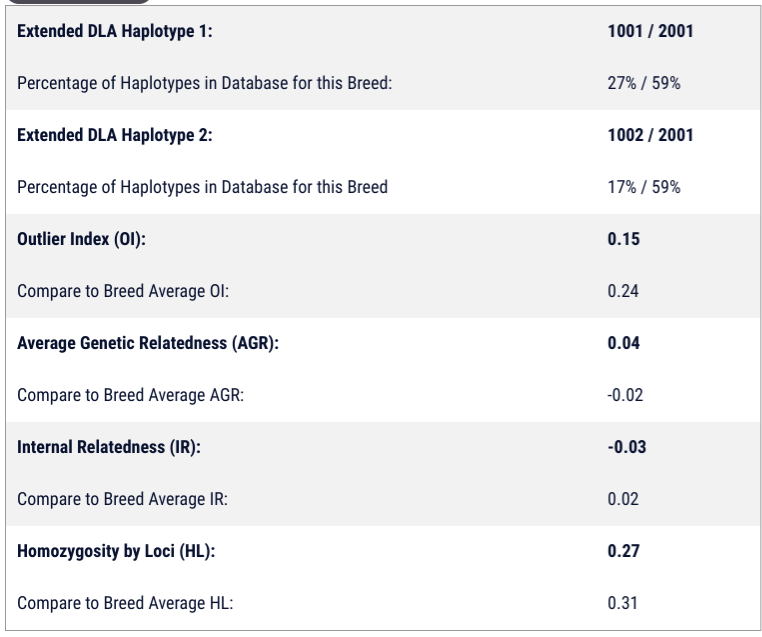
OI: This particular bitch has genetics that are very well represented in this population with an OI of .15, well below the breed average of .24. The lower the Outlier Index is, the more typical the dogs ancestry is. Indeed, her pedigree shows she is from a long history of show bred poodles, which generally tend to have very well represented genetics in this population and consequently low OIs, so this value was not a surprise. For the next generation we would suggest trying to improve this number to help mitigate this breed’s genetic bottleneck and risk for breed specific disease in her puppies.
AGR: We call this the more breeding mates number. The lower this number, the more unrelated mates your dog or bitch will have in the database. In this case, her AGR is .04, which means she has fewer unrelated breeding mates in this population than the typical Standard Poodle. This is likely because her OI shows that she has very well represented genetics for this population.
IR: This is the inbreeding estimate for her and it shows she is slightly less inbred than the typical Standard Poodle. Even if this number were high, it would be easy to reduce it in the next generation by breeding to an unrelated mate. In Standard Poodles, a high IR increased risk for the breed specific disease sebaceous adenitis.
DLA: Remember, this is last aspect we look at. We see she has 1001 paired with 2001, and 1002 paired with 2001. These are some of the most common DLA haplotypes in the Standard Poodle population. Her puppies will have a 50% chance of receiving 1001/2001 and 50% chance of receiving 1002/2001 from her. These numbers do not change generation to generation and neither is associated with a breed specific disease.
The Stud
Now let us take a look at the potential stud. What does his genetic report say about him in reference to the population?
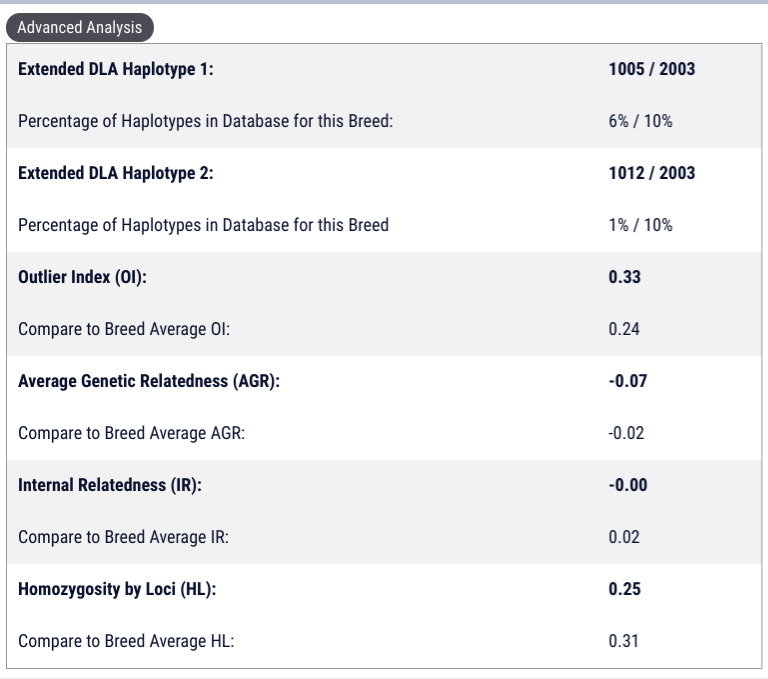
So looking at the three aspects – OI, AGR and IR – what do we see?
OI: This particular stud has genetics that are not well represented in this population with an OI of .33, which is well above the breed average of .24. For this reason, assuming he’s healthy and sound, he is of value to the population. (Of course, selection for type, temperament etc are still important!)
AGR: Remember, we call this the more breeding mates number. The lower this number, the more mates in the database that will be unrelated to your dog or bitch. In this case, his AGR is -.07, which means he has more unrelated breeding mates in this population than the typical Standard Poodle. This is likely because his OI shows that he is very atypical for this population.
IR: This is the inbreeding estimate for him and it shows he is slightly less inbred than the typical Standard Poodle.
DLA: The last thing we look at! We see he has 1005 paired with 2003, and 1012 paired with 2003. These DLA haplotypes are in less common in the Standard Poodle population, for the most part, but not super rare. His puppies will have a 50% chance of receiving 1005/2003 and 50% chance of receiving 1012/2003 from him. These numbers do not change generation to generation. Neither DLA haplotype is associated with breed specific disease in this population.
The Breeding
Remember, we encourage first looking at the breed conservation measurements OI, IR and AGR when we are considering test breedings. We currently cannot predict AGR for litters, so we suggest that you pay attention to the OI of the litter, as we have found that OI and AGR are significantly inversely related to one another in all breeds in our database as a whole. This means, in general if you increase your OI, you will also decrease your AGR.
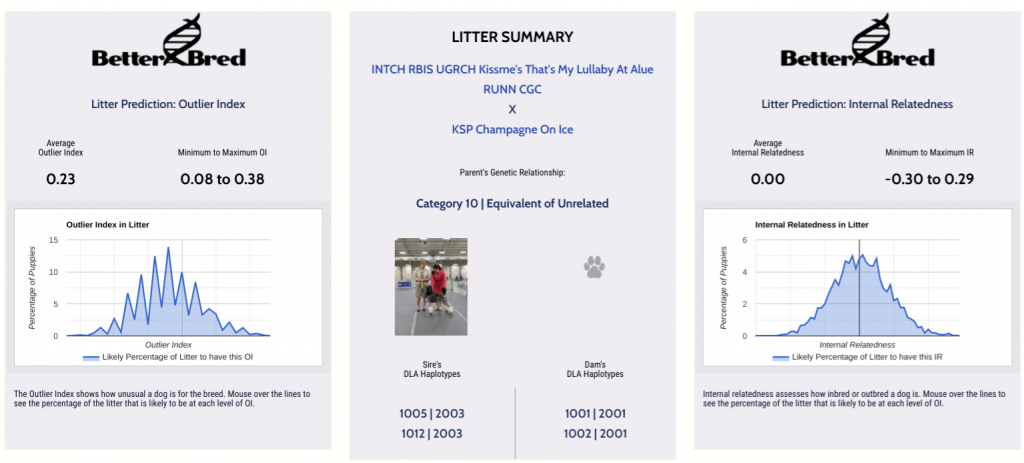
On first glance, we see the average OI is .23, or just below the breed average. We also see that the average IR (inbreeding) tells us that the puppies will be around a 0 IR. Looking also at the DLA haplotypes, we can tell that all puppies would have two different DLA haplotypes. So first impression, this breeding looks reasonably good. Let’s dig a little deeper.
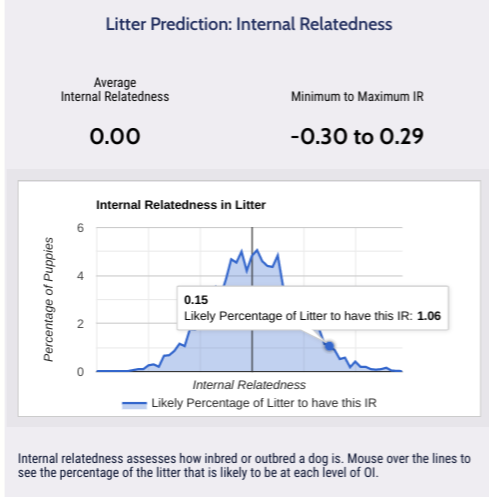
IR – We usually tell breeders to take a look at the range that is predicted for IR. You MUST be comfortable with both the low and high end. But, all breedings in a closed genepool will likely have a broad predicted inbreeding range, because of the very nature of purebred dogs. At some point in the pedigree of every purebred dog there will have been relatives that they had in common, when looking all the way back to the founders or bottleneck events. But we can reasonably reduce the inbreeding while still selecting for type, and this is one power of using our predictive software (whether you want to linebreed or outcross)! When we hover over the graph, we see a fairly low percentage of the puppies is predicted to fall at the high inbreeding value of .15 or above.
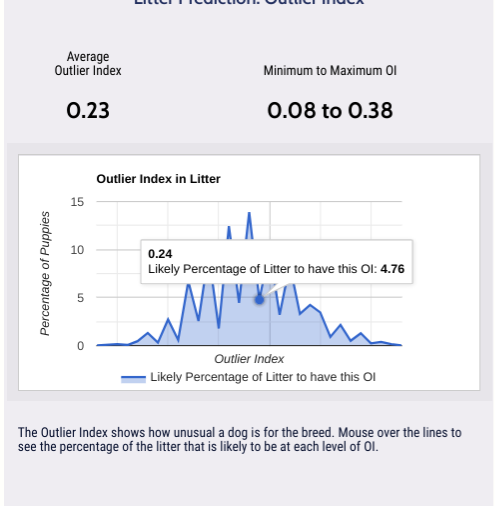
OI – Then we hop over to the OI and take a look. While the average for the breeding is below the Standard Poodle population’s average, when we take in to account the low OI of the dam, this is an improvement on her. As long as the puppy selected is above the dam’s OI, this breeding will have improved on the dam and, if above breed average, also helped breed away from the Standard Poodle bottleneck. As we can see in the range, many will fall at or above breed average. Like in IR, however, every breeder must be okay with knowing that your puppies may also have the lower range of the graph, which in the case of Standard Poodles increases risk for breed specific disease. Now, breeding away from a bottleneck is a marathon and not a race and we as breeders must also keep this in mind.
Lastly, DLA. Under each “Litter Analysis” you will find a section that tells you exactly what DLA haplotypes to expect in your litters. Here you can see (in the image below) that all the puppies will be heterozygous in the DLA region of their genome. To read more about DLA, click here.

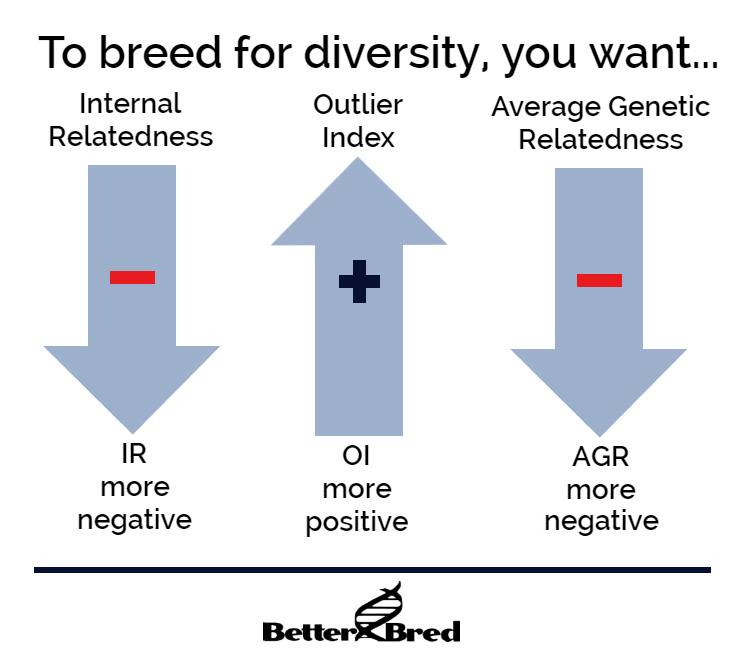
Our Recommendations
We are often asked to give our opinion on test breedings. In general, we suggest breedings should try to breed to improve the breed average, or improve your next generation. But, improve how?
- We suggest reducing inbreeding (lower IR – ideally at or below 0).
- We suggest lowering your AGR, which helps your dog have more breeding mates. Breed for a lower than breed average or lower than the previous generation’s AGR (this is done by selecting for a litter average OI higher than the previous generation or population average).
- Raise your next generations OI to help breed away from the genetic bottleneck. Oi is the only measurement on BetterBred that you want to increase!
Remember again that breeding for conservation is a complex topic, with nuance. We would never suggest breeding solely for the numbers, but rather look at the scope of the whole dog and your program goals alongside the genetics. Selection for the whole dog is and always will be necessary as we steward our lines and work to preserve our breed. Breeding for preservation of a breed is a calling and not an easy one. Thank you to those breeders who strive to be continual students and who serve their breeds.
Want to join in and start using our database? We have both public and premium memberships. We look forward to you joining our breeding community!
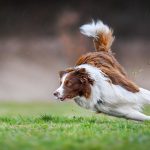 Previous Post
Previous Post Next Post
Next Post


